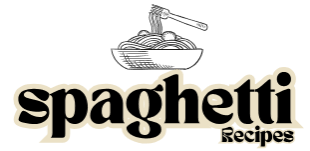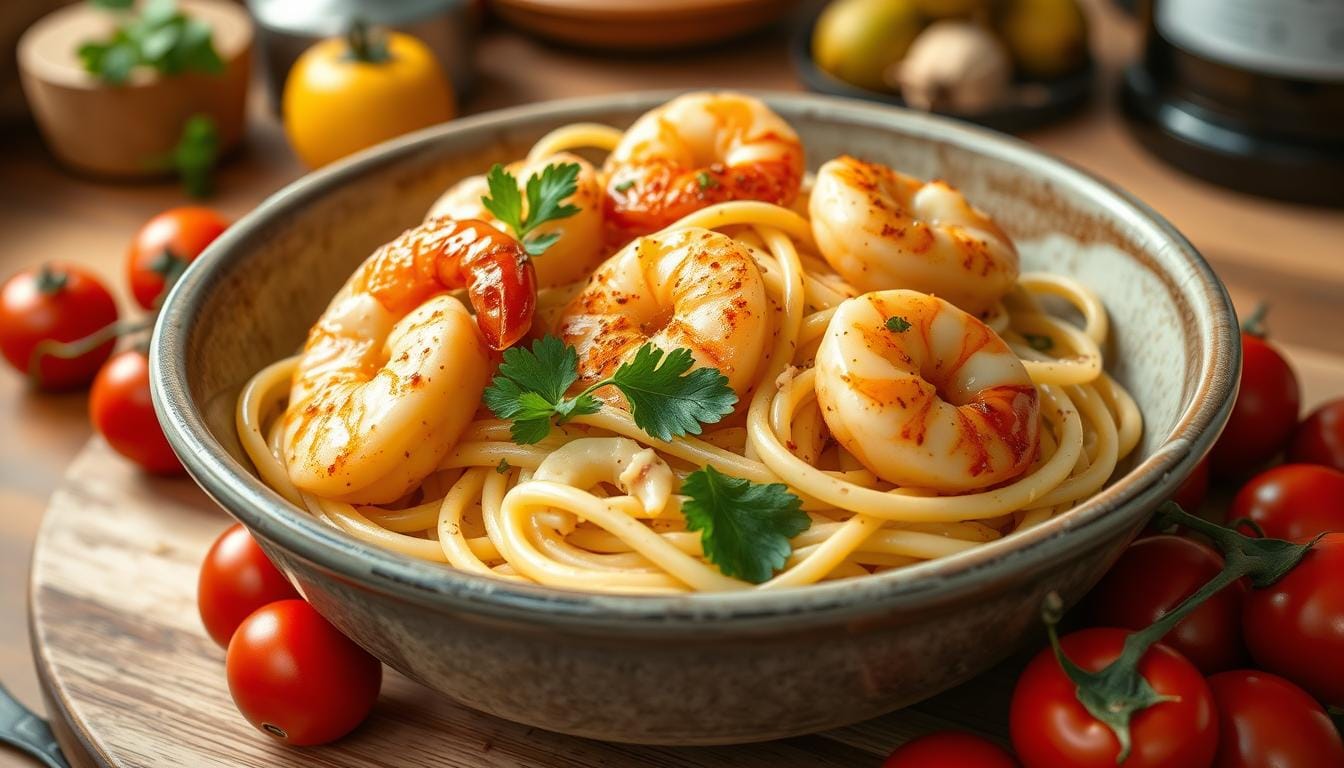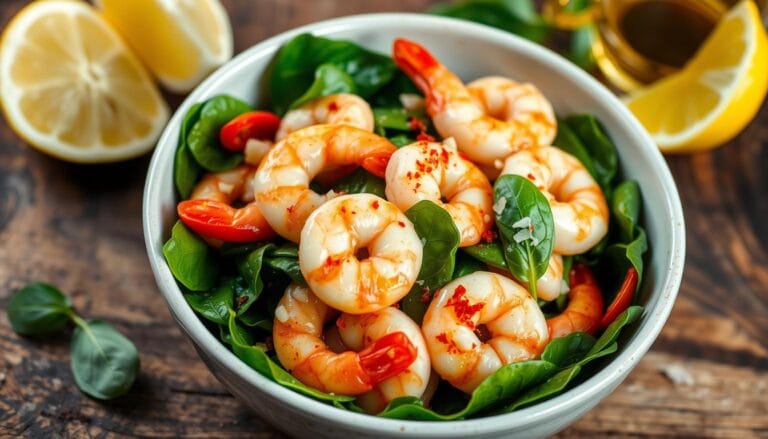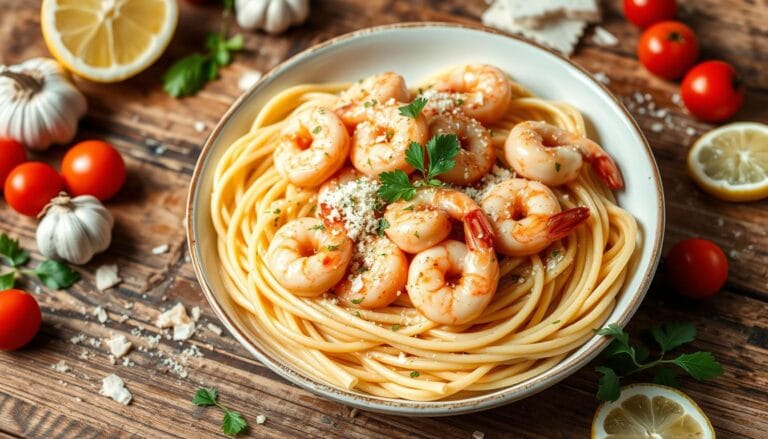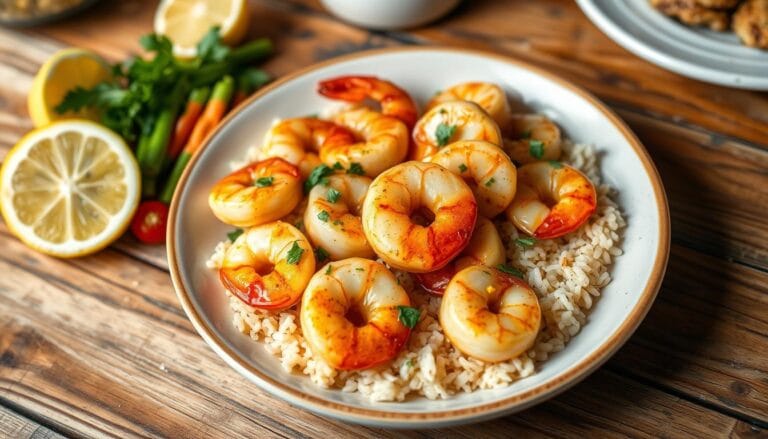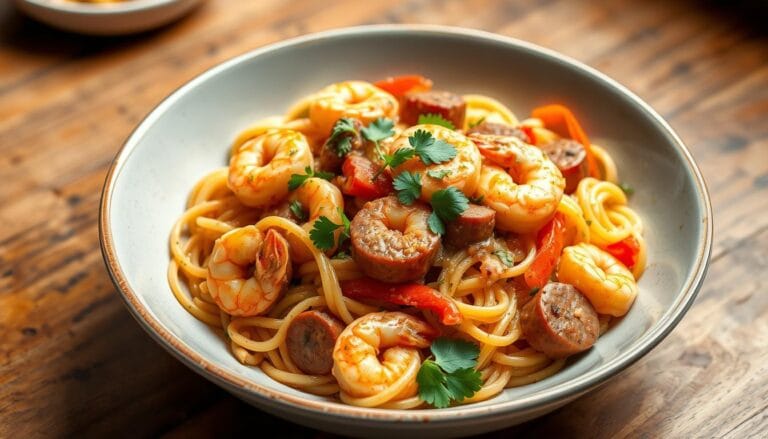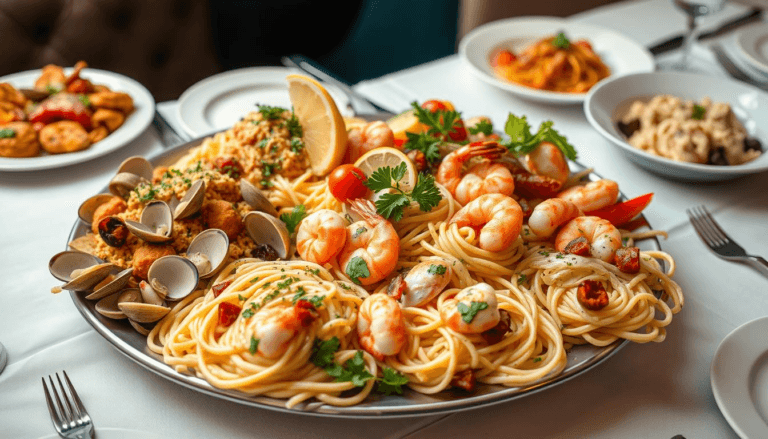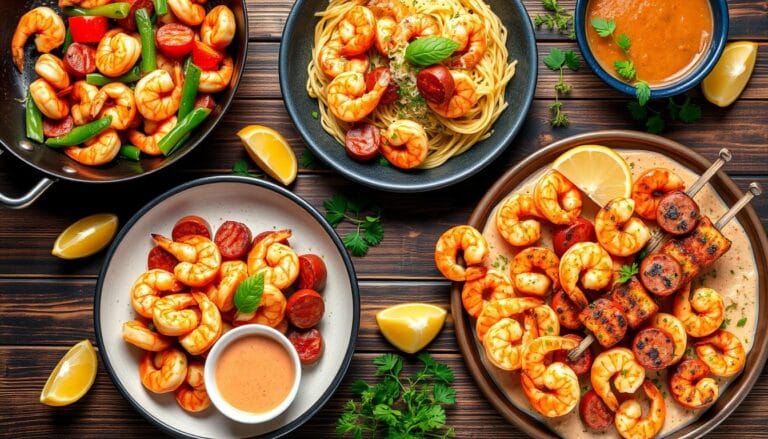Learn how to make a delicious shrimp and scallop pasta with simple ingredients.
Table of Contents
The sun set, and the salty breeze hit my face. It reminded me of the sea’s bounty coming to my table. I was in Newport, Rhode Island, famous for its fresh seafood. I wanted to make a dish that would take my guests to a coastal culinary paradise.
The shrimp and scallop pasta recipe I’m sharing is the result of that journey. It’s a delicious mix of flavors that will make you want more.
Are you planning a romantic dinner or a special occasion? Or maybe you just want a fancy weeknight meal? This 30-minute recipe will make your dinner special. It has jumbo shrimp, large sea scallops, and angel hair pasta in a garlic-infused white wine sauce.
This shrimp and scallop pasta dish will take you to the heart of the Italian coastline. Let’s explore how to make this seafood pasta masterpiece.
Understanding Shrimp and Scallop Pasta Essentials
Seafood pasta dishes come from Italy’s rich culinary history. Shrimp and scallops are a favorite mix, loved for their taste and texture. This combo makes a pasta dish that will wow your guests.
History of Seafood Pasta Dishes
Seafood pasta started in Italy’s coastal areas. Here, shrimp, scallops, and fish were used in pasta for ages. These dishes grew, influenced by local flavors and seasonal seafood.
Why This Combination Works So Well
Scallops and shrimp taste great together. Scallops are soft, while shrimp are firm. This mix of flavors and textures is perfect for pasta.
Basic Kitchen Equipment Needed
- Large skillet or sauté pan for cooking the seafood
- Pasta pot for boiling the noodles
- Food processor or blender for making a breadcrumb topping (optional)
- Tongs, ladle, and other utensils for handling and serving the pasta
With the right tools and ingredients, you can make a tasty shrimp and scallop pasta. Let’s explore how to pick the best seafood for your dish.
Selecting the Perfect Seafood Ingredients
Creating a delicious shrimp and scallop pasta dish starts with top-notch seafood. Choose extra-large or jumbo shrimp and large sea scallops. These fresh or high-quality frozen seafood choices promise an unforgettable meal.
It’s also important to pick seafood that’s good for the planet. Look for fresh shrimp and scallops that are caught or farmed responsibly. This choice helps protect our oceans and ensures you get the best quality ingredients.
Before cooking, clean and devein the shrimp, and rinse the scallops. This step boosts the flavor and texture of your dish. It lets the seafood’s natural sweetness and briny taste come through.
“The secret to a truly amazing shrimp and scallop pasta lies in the careful selection of fresh, quality ingredients. Invest in the best and you’ll be rewarded with a dish that will delight your taste buds.”
By paying attention to these details, you can make your shrimp and scallop pasta truly special. With the right seafood ingredients, you’re on your way to a memorable meal at home.
Essential Pasta and Sauce Components
Creating a tasty shrimp and scallop pasta dish starts with the right pasta and sauce. Angel hair pasta is perfect, with its thin strands that match the seafood’s tenderness. You can also use linguine or spaghetti for a heartier taste.
Choosing the Right Pasta Type
Angel hair pasta is ideal for this dish, thanks to its thin, long noodles. It cooks quickly and absorbs the sauce’s flavors well. Linguine or spaghetti offer a thicker texture, great for the creamy sauce.
Wine and Butter Sauce Basics
The sauce is a mix of white wine, butter, and garlic. A Chardonnay or Pinot Grigio adds a nice balance of acidity and richness. The butter makes the sauce smooth and clingy, coating the pasta and seafood.
Fresh Herbs and Seasonings
Fresh herbs like parsley are essential for boosting flavors. They add a bright, herbaceous taste that pairs well with the seafood. A bit of Old Bay seasoning adds depth, enhancing the shrimp and scallops’ natural flavors.
“The right pasta and sauce can transform a good seafood dish into an exceptional culinary experience.”
Preparation Steps for Perfect Results
To make a delicious shrimp and scallop pasta, start by drying your seafood with paper towels. This helps the scallops and shrimp get a great sear and caramelization. Then, get all your ingredients ready before cooking. Mise en place, or “everything in its place,” makes cooking smoother and ensures everything works together well.
While the pasta cooks, cook the vegetables separately. This lets each ingredient’s flavor shine, making the dish more complex and balanced. Remember to save some pasta water. This water is key to a creamy sauce.
- Pat seafood dry before cooking to encourage browning.
- Prepare all ingredients beforehand for an organized mise en place.
- Cook vegetables separately to develop their flavors.
- Reserve pasta cooking water to use in the sauce.
- Coordinate timing to ensure all components are ready simultaneously.
| Ingredient | Quantity |
|---|---|
| Bay Scallops | 1 lb. |
| Cooking Time | Under 20 minutes |
| Breadcrumb Mixture | 1/2 cup panko, 1/4 cup pine nuts |
| Garlic | 2 cloves |
| Recommended Scallop Internal Temp | 115°F |
By following these steps, you’ll prepare for a seafood pasta dish that will impress. With your cooking preparation and mise en place done, you’re on your way to a meal that rivals a restaurant’s.
The Art of Cooking Scallops
Scallops are a delightful seafood option that can transform a simple pasta dish into a culinary masterpiece. The key to achieving mouthwatering seared scallops lies in mastering the art of temperature control and searing technique. Let’s dive into the secrets of cooking scallops to perfection.
Temperature Control Tips
Proper temperature management is crucial when cooking scallops. You want to ensure that the internal temperature of the scallops reaches 115°F for an optimal texture. Overcooking can lead to a rubbery, tough consistency, so it’s essential to keep a close eye on the cooking process.
Achieving the Perfect Sear
To achieve a golden-brown sear on your scallops, you’ll need to use high heat. Sear the scallops for about 2-3 minutes per side, or until they develop a nice caramelized crust. Be mindful not to overcrowd the pan, as this can prevent the scallops from searing properly. Patience and attention to detail are key when searing scallops to perfection.
By following these temperature control and searing techniques, you’ll be able to create scallops that are tender, juicy, and bursting with flavor – the perfect complement to your delectable shrimp and scallop pasta dish.
Proper Shrimp Preparation Techniques
Getting your shrimp ready right is key for the best cooking shrimp taste and texture in your pasta. Here are some top tips for perfect shrimp prep:
- Peel and devein the shrimp. This makes them look better and removes the intestinal vein, which can taste bad.
- Pat the shrimp dry with paper towels. This helps them sear and caramelize well.
- Season the shrimp with salt, pepper, and garlic powder. This adds great flavor to your shrimp doneness.
When cooking the shrimp, watch them closely. They should turn pink and curl into a C or U shape when done, in about 2-3 minutes per side. Don’t overcook them, or they’ll become tough and rubbery.
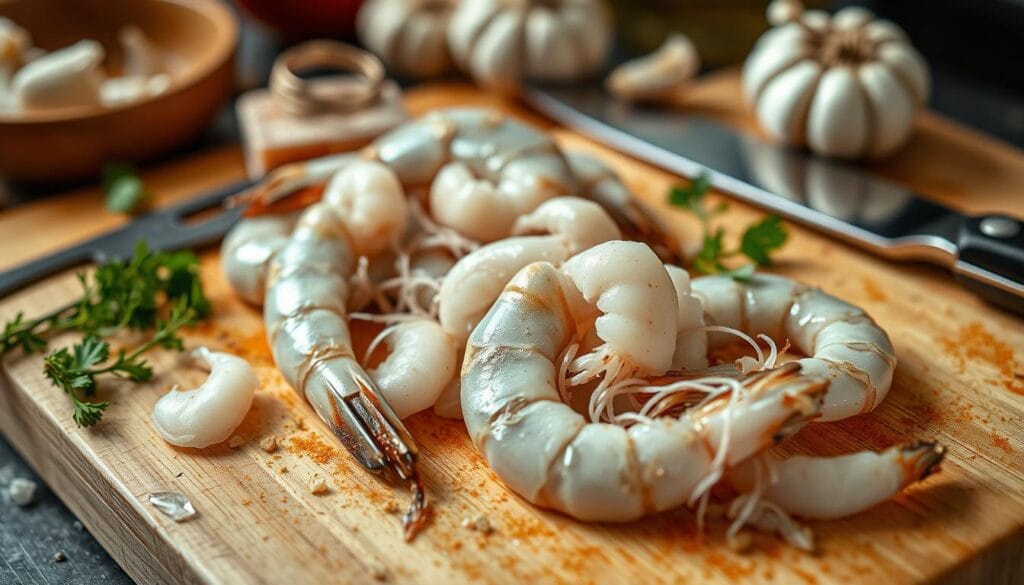
Remember, cooking shrimp fast and taking them off heat quickly is crucial. This way, you get tender, juicy shrimp that go great with pasta and sauce. By following these shrimp prep tips, you’ll make a delicious shrimp and scallop pasta dish.
Creating the Perfect Garlic Wine Sauce
Improving your shrimp and scallop pasta dish starts with a great garlic wine sauce. This sauce is the dish’s heart. With a few simple steps, you can mix flavors perfectly, making your dish stand out.
Wine Selection Guidelines
Choosing the right white wine is crucial for a tasty garlic wine sauce. Go for a buttery or oaky Chardonnay or a crisp Pinot Grigio. These wines add citrus notes and sweetness. Stay away from dry or acidic wines, as they can overpower the seafood.
Balancing Flavors
To get the flavors just right, control the wine, butter, garlic, and shallots mix. Start by cooking the garlic and shallots in butter until they smell great. Then, slowly add the white wine, letting it simmer and reduce. This will concentrate the flavors.
Season with salt and pepper as needed. Finish with lemon juice and zest to brighten the taste. Remember, patience and detail are key. Let the flavors blend and the sauce thicken. You’ll get a dish that will wow everyone.
Mastering Al Dente Pasta Cooking
Getting the perfect al dente texture is key for a great shrimp and scallop pasta dish. Al dente pasta has a firm bite and a great texture. It’s the perfect base for the seafood and sauce.
To cook al dente pasta, follow these easy steps:
- Cook the pasta as the package says, but watch it closely. Avoid overcooking to prevent a mushy texture.
- Use a timer and taste the pasta a minute or two before it’s done. It should have a slight firmness when bitten into.
- When the pasta is just right, save 1/2 cup of the cooking water before draining. This water helps the sauce stick to the pasta, making the dish more flavorful.
Learning to cook al dente pasta is crucial for a balanced shrimp and scallop pasta. By following these steps, your pasta will be perfectly cooked. It will be ready to pair with the seafood and sauce.
| Pasta Type | Cooking Time (Al Dente) | Recommended Cooking Water |
|---|---|---|
| Spaghetti | 8-10 minutes | 1/2 cup |
| Penne | 10-12 minutes | 1/2 cup |
| Linguine | 8-10 minutes | 1/2 cup |
| Farfalle (Bow Tie) | 12-14 minutes | 1/2 cup |
The cooking time and water needed can change based on the pasta brand and type. Always watch the pasta closely and adjust the cooking time for the perfect al dente texture.
“The secret to a perfect pasta dish is in the cooking of the pasta itself. Al dente is the key to unlocking the true essence of the ingredients.”
Step-by-Step Shrimp and Scallop Pasta Recipe
Take your seafood pasta to the next level with this shrimp and scallop recipe. It features perfectly seared scallops and tender shrimp. They’re mixed with a savory garlic-wine sauce and served with al dente pasta. This dish is a restaurant-quality meal you can make at home.
Timing and Coordination
To make sure everything comes together perfectly, timing is key. Start by boiling a large pot of salted water. Cook the pasta until it’s al dente, following the package instructions. Before draining, save 1/2 cup of the pasta water.
While the pasta cooks, prepare the garlic-wine sauce. Melt butter in a pan and sauté minced garlic until it smells great. Then, add white wine to deglaze the pan. Let the sauce simmer and thicken a bit. Meanwhile, pat the shrimp and scallops dry and season them with seafood seasoning.
Plating Suggestions
- Divide the cooked pasta among plates or bowls.
- Top the pasta with the seared shrimp and scallops.
- Spoon the garlic-wine sauce over the seafood and pasta.
- Garnish with fresh chopped parsley or basil, and, if desired, sprinkle with toasted breadcrumbs for a crunchy texture.
Serve this shrimp scallop pasta recipe right away for the best taste and texture. This seafood pasta dish will impress your guests or family.
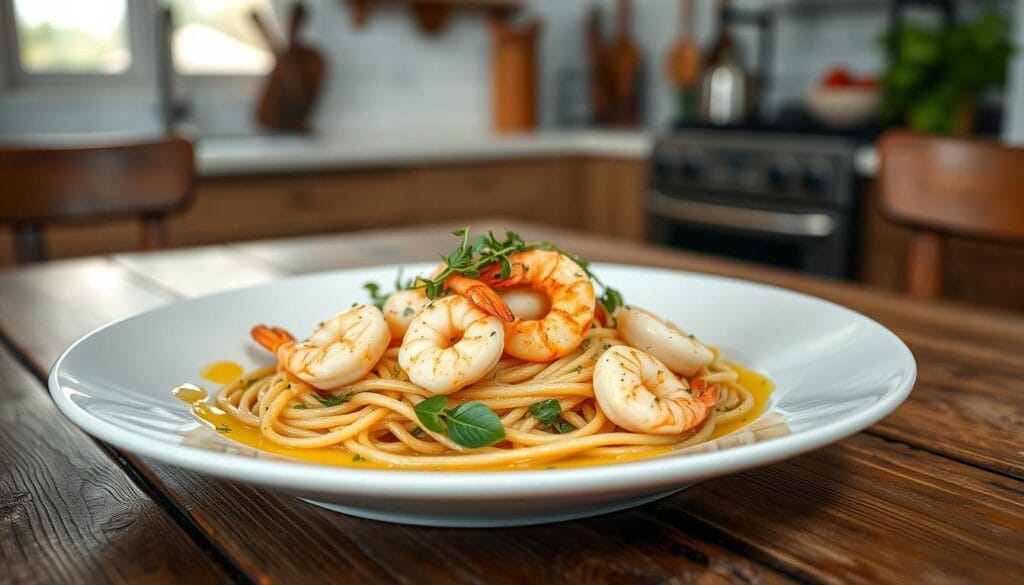
“The key to this recipe is perfectly searing the scallops and shrimp to lock in their natural sweetness, then tossing them with the al dente pasta and that incredible garlic-wine sauce. It’s a true seafood lover’s dream!”
Common Cooking Mistakes to Avoid
When making a tasty shrimp and scallop pasta dish, it’s key to avoid common mistakes. These errors can ruin the flavor and texture of your seafood. With a few simple tips, you can easily sidestep these issues.
One big mistake is overcooking the seafood. Scallops and shrimp become tough and rubbery if cooked too long. To prevent this, keep an eye on cooking times. Use a meat thermometer to check if the seafood is at 145°F (63°C).
Another mistake is underseasoning the dish. Seafood’s delicate flavor can be lost if not seasoned right. Try different herbs, spices, and a bit of lemon or wine. This will bring out the natural sweetness of the seafood.
Lastly, don’t use low-quality ingredients. Good seafood, pasta, and other ingredients make a big difference. Choose fresh, sustainable options and work with trusted vendors.
By avoiding these mistakes, you’ll make a delicious shrimp and scallop pasta dish. Your family and friends will love it.
“Properly cooked seafood should reach an internal temperature of 145°F (63°C).”
- Don’t skip drying the seafood before cooking, as this can lead to steaming instead of searing.
- Ensure the pasta is not overcooked, as this can result in a mushy texture that overpowers the delicate seafood flavors.
- Avoid using cold ingredients, which can cool the dish too quickly and prevent the flavors from fully developing.
Flavor Enhancement Tips
Boosting the taste of your shrimp and scallop pasta is simple. Begin with a mix of aromatic seasonings. Use seafood seasoning, fresh herbs, and a bit of lemon zest. These will bring out the briny taste of the seafood and add a fresh, zesty flavor.
Seasoning Secrets
Season the shrimp and scallops well before cooking. A sprinkle of seafood seasoning, black pepper, and a pinch of salt are key. You can also try paprika or a bit of cayenne for a hint of heat.
Garnishing Options
- Fresh parsley: Chopped parsley adds a bright, herbaceous note and a pop of color to the dish.
- Lemon wedges: A squeeze of fresh lemon juice just before serving can brighten up the flavors and balance the richness of the sauce.
- Olive oil drizzle: A drizzle of high-quality extra virgin olive oil can elevate the dish’s overall flavor and presentation.
By adding these simple yet impactful flavor enhancers, your shrimp and scallop pasta will become unforgettable. The mix of aromatic seasonings, fresh herbs, and vibrant garnishes will make the dish more flavorful. Your taste buds will thank you.
Wine Pairing Recommendations
Choosing the right wine for your shrimp and scallop pasta can make a big difference. The best wine temperature for seafood pasta is between 45°F and 60°F. This ensures the wine and pasta flavors work well together.
For a great match, try a crisp white wine like Chardonnay or Pinot Grigio. These wines enhance the seafood’s delicate taste and cut through the creamy sauce’s richness. Sauvignon Blanc or unoaked Chablis are also good choices, offering a fresh contrast to the pasta.
If you like red wine, a light-bodied Pinot Noir can be a nice surprise. It pairs well with the seafood and pasta, thanks to its subtle flavors. For a bolder taste, a Chianti or Sangiovese can handle the dish’s heartier parts.
| Wine Variety | Pasta Sauce Pairing | Serving Temperature |
|---|---|---|
| Chardonnay | Creamy, cheese-based sauces | 45°F – 55°F |
| Sauvignon Blanc | Seafood-based, pesto, and vegetable-based sauces | 45°F – 55°F |
| Pinot Noir | Vegetable-based sauces | 55°F – 60°F |
| Chianti | Tomato-based sauces | 55°F – 60°F |
Finding the perfect wine pairing is all about balance. Try different wines to see which one goes best with your shrimp and scallop pasta.
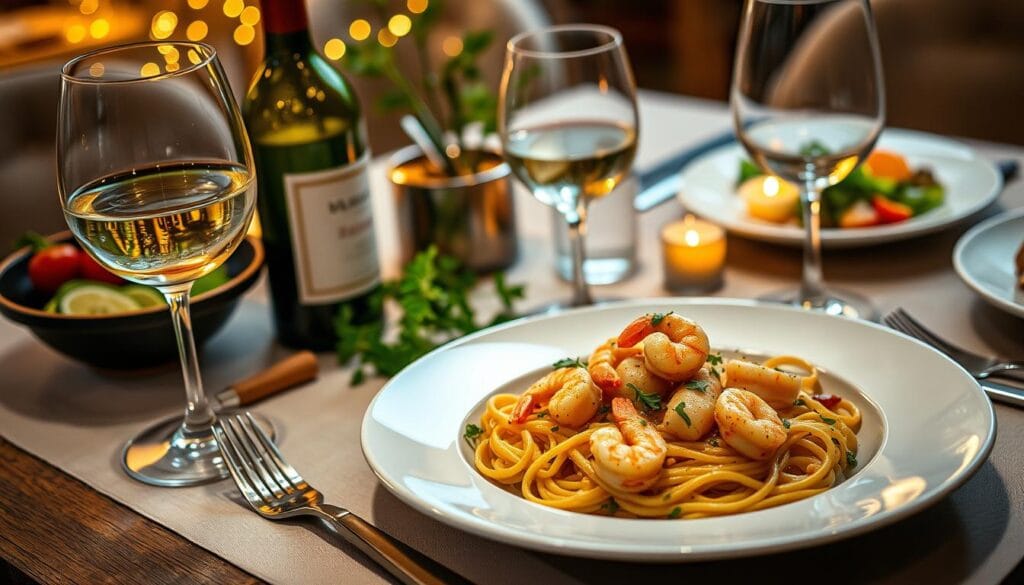
Storage and Reheating Guidelines
Storing and reheating your shrimp and scallop pasta right is key. It keeps the flavors bright and the seafood fresh. Follow these tips to enjoy your leftovers fully.
Proper Storage Methods
Put your shrimp and scallop pasta in an airtight container. Then, refrigerate it for 2-3 days. This keeps the flavors in and prevents spoilage. Don’t leave it out for more than two hours to avoid bacteria.
Best Reheating Practices
To reheat, gently warm the pasta on the stovetop. Add a bit of broth or water to keep it moist. Heat it on low to medium, stirring often, until it’s warm. Avoid using the microwave to prevent overcooking the seafood.
By using these storage and reheating tips, you can enjoy your homemade shrimp and scallop pasta leftovers for days.
“The key to enjoying pasta leftovers is to reheat them gently, without overcooking the seafood.”
Recipe Variations and Modifications
Explore a world of delicious variations and customizations for your seafood pasta. Whether you love shrimp or scallops, you can make this dish your own. It’s all about tailoring it to your taste.
Try different seafood in your pasta. Swap shrimp and scallops for crab meat or lobster. Each type of seafood adds its own flavor, making your dish unique.
Play with seafood pasta variations by changing pasta shapes. Try fusilli or rigatoni instead of spaghetti or penne. These changes can make your dish look and feel different.
For a creamy version, add half-and-half or heavy cream to the sauce. This simple step makes the dish rich and indulgent.
Customize the seasonings to your liking. Add fresh herbs like basil or parsley, or some red pepper flakes for heat. Adjust the garlic, salt, and pepper to match your taste.
Also, add vibrant vegetables to your pasta. Try sautéed spinach, roasted bell peppers, or cherry tomatoes. They add color and freshness to your seafood pasta variations.
With these recipe modifications, you can make your pasta truly special. Let your creativity shine and enjoy a dish that’s all your own.
Nutritional Information and Benefits
Shrimp and scallops are not just tasty, but also packed with nutrients. They add a lot of good stuff to your seafood pasta. These ingredients are full of protein, vitamins, minerals, and heart-healthy fats.
A 3.53-ounce (100-gram) serving of scallops has 137 calories, 24 grams of protein, and 205 mg of omega-3 fatty acids. Scallops are also rich in trace minerals like selenium, zinc, and copper. These minerals are important for your health and well-being.
Eating seafood, like this shrimp and scallop pasta, is good for you. The pasta gives you complex carbs for energy. Meanwhile, the seafood offers high-quality protein and healthy fats. Enjoying this shrimp and scallop pasta dish in moderation lets you enjoy the taste while getting important nutrients.
FAQ
What is the total preparation time for this shrimp and scallop pasta recipe?
This 30-minute pasta recipe is perfect for special occasions, romantic date nights, and celebrations.
What are the key ingredients in this seafood pasta dish?
The dish features jumbo shrimp, large sea scallops, and angel hair pasta in a garlic wine sauce.
What equipment is needed to prepare this recipe?
Essential equipment includes a large skillet, pasta pot, and food processor for making breadcrumb topping.
What type of seafood is best to use?
Use extra-large or jumbo shrimp and large sea scallops for best results. Fresh or high-quality frozen seafood can be used.
What type of pasta works well in this Shrimp and Scallop Pasta dish?
Angel hair pasta is ideal for this shrimp and scallop pasta dish, but linguine or spaghetti can be used as well.
What ingredients are in the garlic wine sauce?
The sauce combines white wine (Chardonnay or Pinot Grigio), butter, and garlic. Fresh herbs like parsley enhance the flavor.
How should the seafood be prepared before cooking?
Pat the seafood dry before cooking. Ensure shrimp are deveined and scallops are properly cleaned.
How do you cook the scallops to get the perfect sear?
Use high heat for searing scallops. Cook until golden brown and firm, about 2-3 minutes per side. Internal temperature should reach 115°F.
How do you know when the shrimp are cooked properly?
Cook shrimp until they are pink and curled into a C or U shape. Avoid an O shape, which indicates overcooking. Shrimp cook quickly, about 2-3 minutes per side.
What type of white wine works best in the sauce?
Use a buttery or oaky white wine with citrus notes, such as Chardonnay or Pinot Grigio.
How do you ensure the pasta is cooked al dente?
Cook the pasta until al dente according to package instructions. Reserve 1/2 cup of the starchy pasta water before draining.
What are some common mistakes to avoid when making this Shrimp and Scallop Pasta dish?
Avoid overcooking seafood, underseasoning, or using low-quality ingredients. Don’t skip drying the seafood before cooking, and ensure the pasta is not overcooked.
What are some ways to enhance the flavors of this seafood pasta?
Use seafood seasoning, fresh herbs, and lemon zest to enhance flavors. Consider adding red pepper flakes for heat. Garnish with fresh parsley, lemon wedges, and a drizzle of high-quality olive oil.
What wine pairs well with this shrimp and scallop pasta dish?
Pair the dish with the same white wine used in cooking, such as Chardonnay or Pinot Grigio. Alternatively, a crisp Sauvignon Blanc or unoaked Chablis can also complement the flavors.
How should leftover shrimp and scallop pasta be stored and reheated?
Store leftovers in an airtight container in the refrigerator for 2-3 days. Reheat gently on the stovetop with a splash of broth or water. Avoid microwave reheating, which can overcook the seafood.
Can this recipe be modified or customized?
Yes, you can swap seafood types, use different pasta shapes, or add vegetables like spinach or roasted peppers. You can also create a creamy version by adding half-and-half or heavy cream, and adjust seasonings to personal taste preferences.
